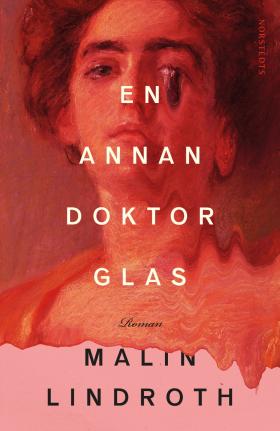
En annan doktor Glas
(Another Doctor Glas)
By Malin Lindroth
reviewed by Joanna Flower
In Malin Lindroth’s latest novel, a young woman from the provinces comes to Stockholm looking for work in the early 1900s. She has ambitions to become a journalist, but her wild personality and mental health issues stand in the way of this dream and instead she becomes a shadowy sort of gossip columnist. During a stay in a mental health asylum, our protagonist befriends a fellow patient, the wife of the renowned Swedish writer Hjalmar Söderberg. On her release, she seeks out the great man himself, using her friendship with his wife as an introduction, with the idea of producing an article on the writer. The narrator manages to ingratiate herself with the Söderberg household and finds herself becoming obsessed with one of Söderberg’s novels. Gradually, she finds herself being drawn into a fusion of personality with his wife, who is still languishing in the asylum.
Hjalmar Söderberg is a much-loved figure in the Swedish literary canon, and he and his works are intimately connected with the literary history of Stockholm. One of his most famous works, Doktor Glas (Doctor Glas, 1905), is written in a confessional, first-person style, and depicts how his obsession with a beautiful young patient, who is in an extremely unhappy marriage, leads to him murdering her husband. En annan doctor Glas (Another Doctor Glas), written in a confessional, first-person style, begins with the anonymous narrator setting out her stall: ‘I want to write about Hjalmar Söderberg. He is the object of my investigation, and I am eager to get started’. I was eager for this too, being a great fan of Söderberg, and at first, this work seemed promising – it was notable, for example, that the only characters in the book referred to by name were Söderberg and his wife, Märta. However, with almost every page, I found myself wondering what I was reading this book for. Söderberg himself does not appear in the narrative until almost page 90, and even then, there were no psychological insights, no deftly drawn portraits of either the man or the artist. Not only that, but his acceptance of this dislikeable protagonist into his intimate circle was so abrupt and unconvincing as to be continually jarring – why would Söderberg open his house and home so royally to a stranger as to treat her like a close member of the family? Was he an intensely needy character? Was it some extreme and misplaced loyalty to his absent wife? But this question is never addressed, so any insight into Söderberg’s character here is by-passed.
The bulk of the narrative focuses on the female descent into madness, which could have had overtones of, say, Charlotte Perkins Gilman, or perhaps even Daphne du Maurier, but, since the narrator is just an occasional house guest with no direct meaning or significance for the Söderberg family, the stakes seemed very low – would this nameless protagonist write an article about Hjalmar Söderberg or not? Frankly, I didn’t care. The narrator’s conclusion is that Doktor Glas was not based on a real life doctor, but was in fact a portrait of Söderberg himself.
It is only the author’s afterward that this rather peculiar book is explained. A writer and playwright known in Sweden for her feminist perspective (her novel Nuckan, The Spinster, made waves in Sweden in 2018), Malin Lindroth explains that she was approached to write a dramatic monologue about Söderberg’s wife, after researchers had discovered reason to doubt whether she had in fact been mentally ill. Lindroth became fascinated by the idea that, at the same time that he was writing Doctor Glas, Söderberg and his powerful friends must have been concocting a way to get rid of his inconvenient wife, and rather than writing a monologue about this piece of information, she decided to write a book about it. This explains the rather thin plot and lack of any real meat to the story. Moreover, Lindroth is also at pains to make clear that the book is not based on documentary evidence, but that all the characters, including ‘Söderberg’ have sprung from her imagination. The language that Lindroth uses in the novel creates a vivid sense of female suffocation in the patriarchal straitjacket of the day, but having stated in the opening section that Hjalmar Söderberg is the object of her investigation, and that ‘I want to express something that will endure. A crazy big truth’, to distance oneself from it all in an afterward, saying that it was all just fiction, renders the overall reading experience quite unsatisfactory, and you are left feeling that you have just been reading the result of a rather self-indulgent intellectual game of intertextuality and sentence-crafting. Without the literary heritage of Söderberg to fall back upon, it seems unlikely that this piece would gain much traction with an English-speaking market.

En annan doktor Glas
Norstedts, 2025, 239 pages
Foreign Rights: Linda Altrov Berg, Norstedts Agency
Malin Lindroth was first published in 1985 and since then has published numerous short stories, poems, novels and literary and cultural criticism. Her plays have been performed in theatres in Sweden and abroad. Nuckan (The Spinster) was reviewed by Fiona Graham in SBR 2019:1-2.
